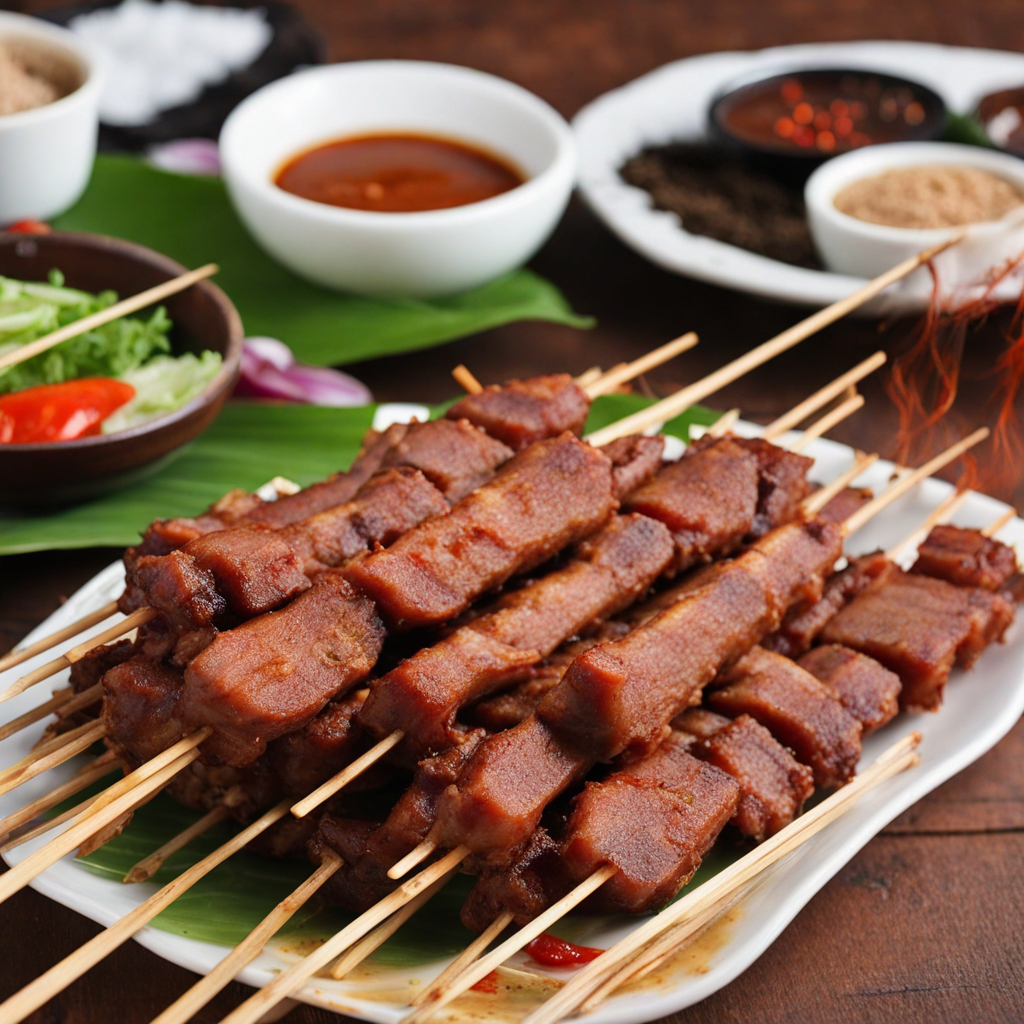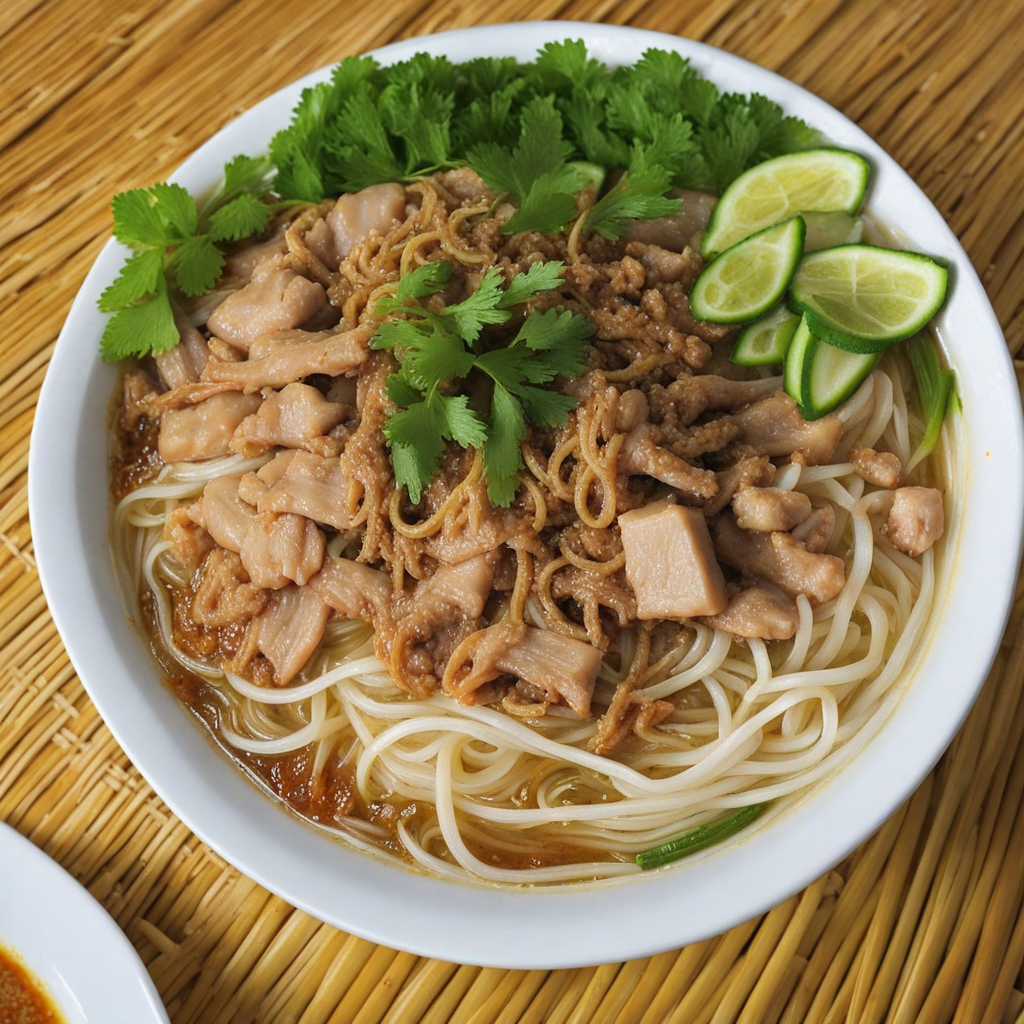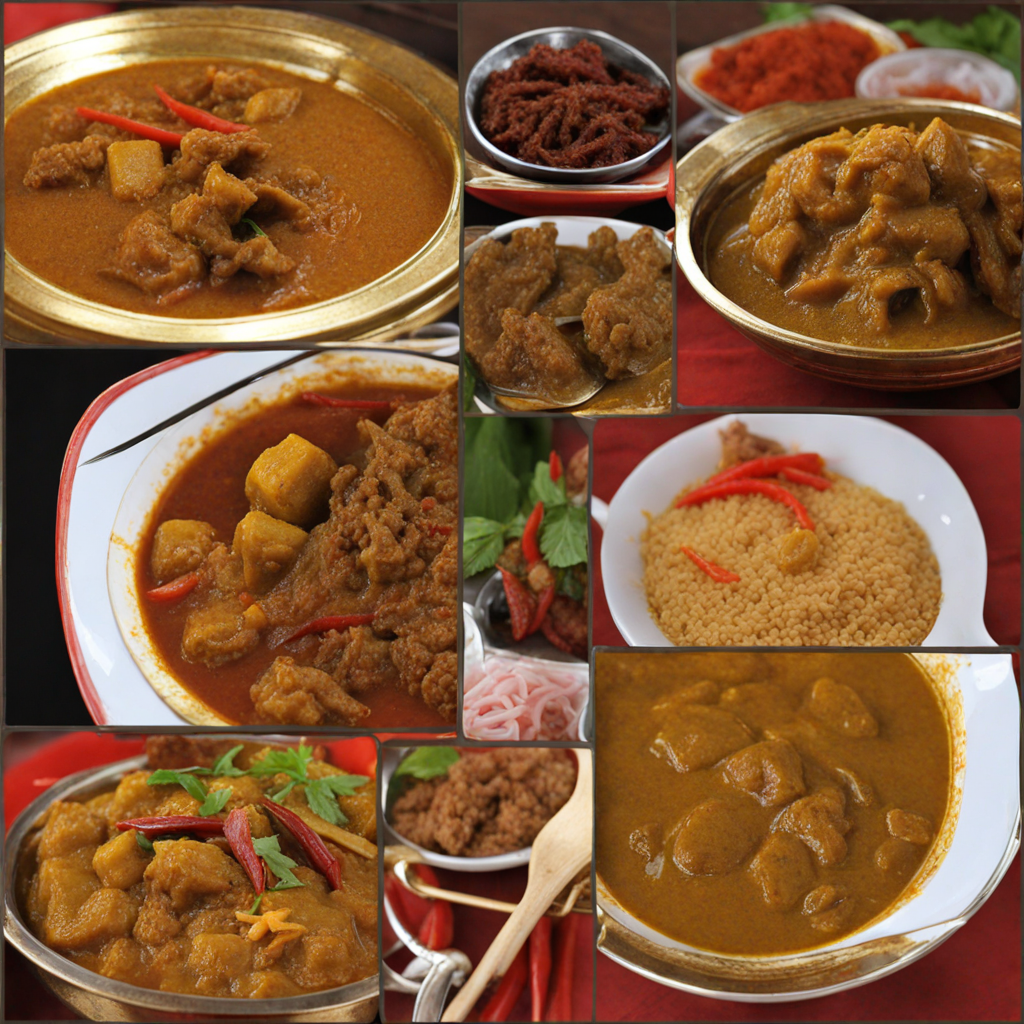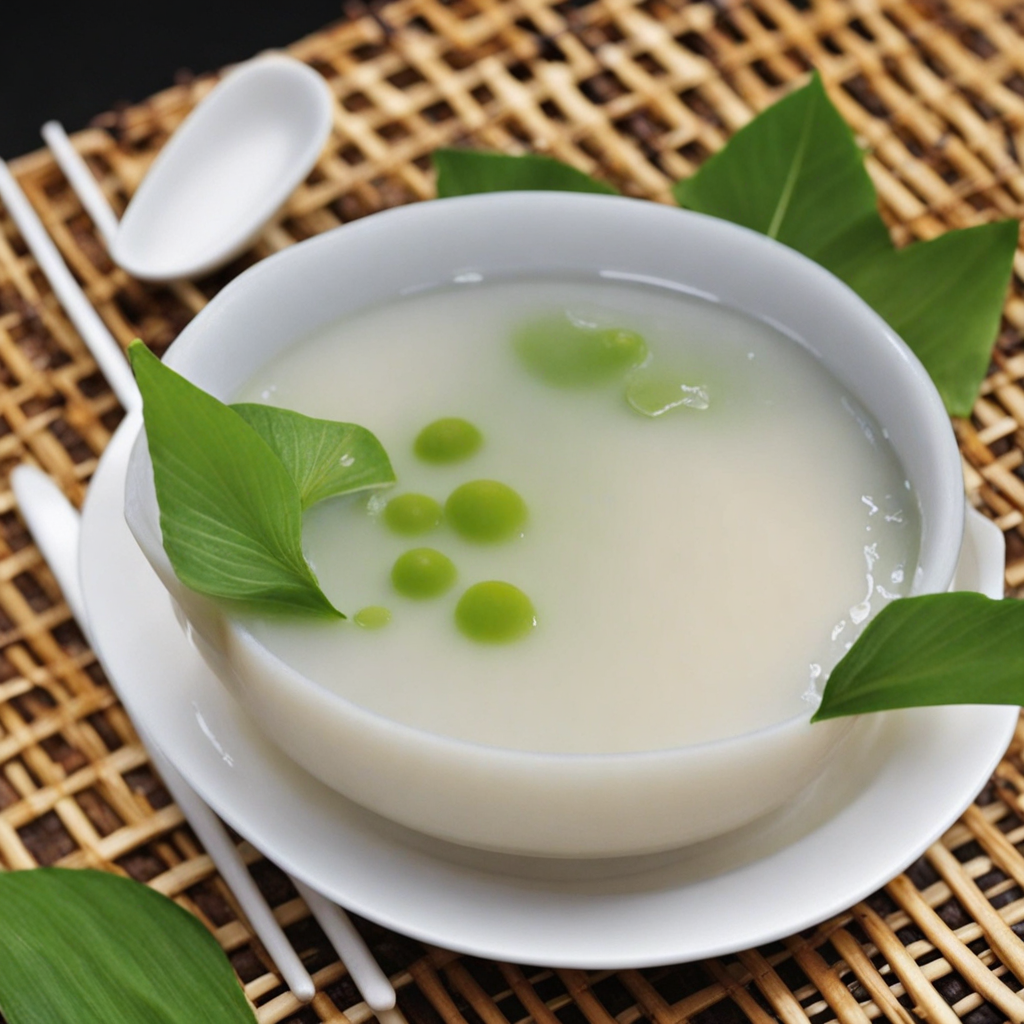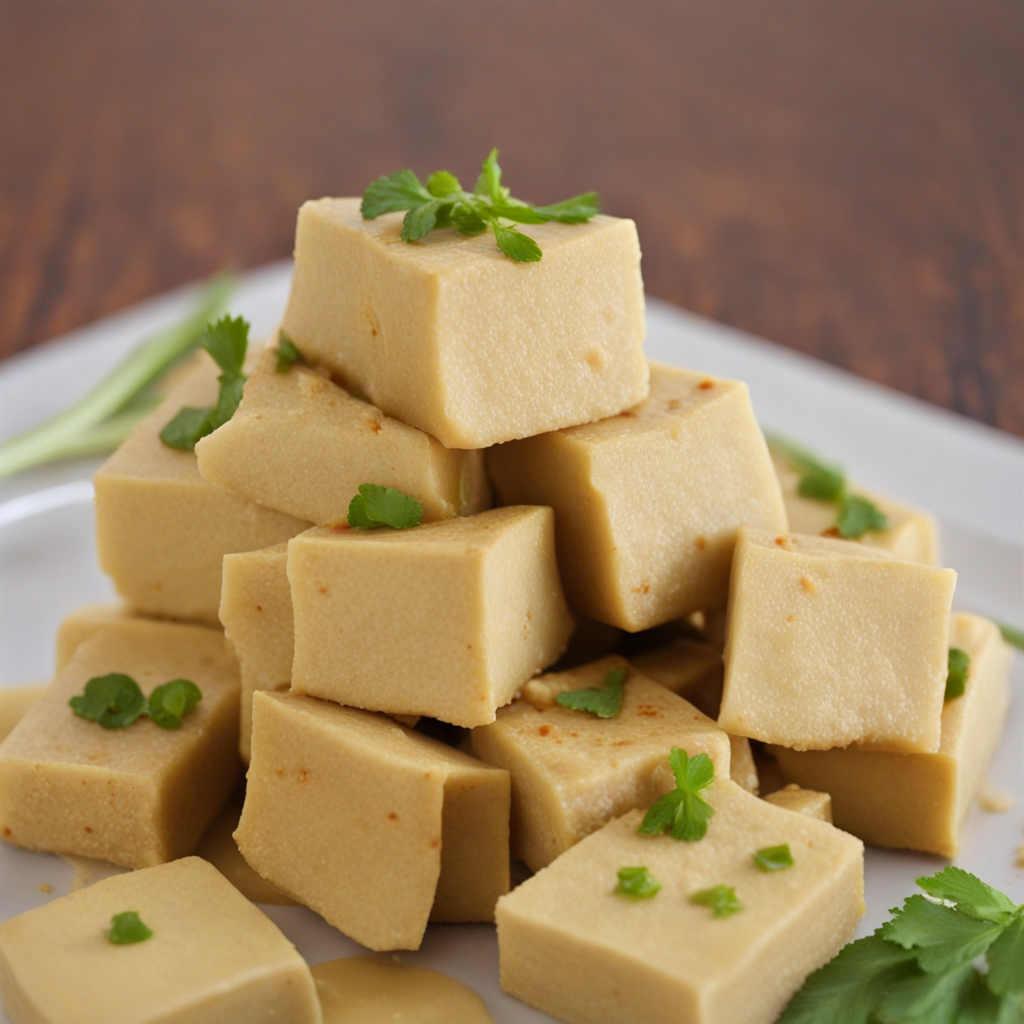Myanmar Pork Stick
'ဝက်သားတုတ်' (pronounced 'wè-tha toak'), commonly known as Myanmar-style pork curry, is a beloved dish that encapsulates the rich culinary heritage of Myanmar. The dish often reflects the country's diverse ethnic backgrounds and its historical connections with neighboring regions. Pork is a staple in Myanmar, particularly in areas where Buddhism is less predominant, as many communities enjoy it as a primary source of protein. Over generations, 'ဝက်သားတုတ်' has evolved into a comfort food that holds a special place in the hearts of many. The flavor profile of 'ဝက်သားတုတ်' is a harmonious blend of savory, spicy, and slightly sweet elements. The dish is notable for its depth of flavor, achieved through a combination of spices and cooking techniques. The pork is typically tender and juicy, absorbing the rich, aromatic sauce that accompanies it. The balance of spices, often including turmeric, chili, garlic, ginger, and sometimes tamarind, creates a fragrant and mouthwatering experience. The result is a dish that is both satisfying and complex, with layers of flavors that unfold on the palate. Preparation of 'ဝက်သားတုတ်' involves several steps, each contributing to the dish's overall richness. First, the pork—usually belly or shoulder—is cut into bite-sized pieces. The meat is marinated with spices and sometimes left to rest for a period to enhance its flavor. The cooking process begins with heating oil in a pot, where onions are sautéed
How It Became This Dish
The History of "ဝက်သားတုတ်" (Wèthathar Tot) from Myanmar #### Introduction "ဝက်သားတုတ်" (Wèthathar Tot), commonly known as pork belly, is a beloved dish in Myanmar, renowned for its rich flavor and culinary versatility. As a staple in Burmese cuisine, it embodies the cultural heritage, agricultural practices, and social customs of the country. This exploration of Wèthathar Tot delves into its origins, cultural significance, and the evolution of its preparation and consumption over time. #### Origins of Wèthathar Tot The roots of Wèthathar Tot can be traced back to the agricultural practices of ancient Myanmar, where the domestication of pigs became prevalent. Pigs were raised not only for their meat but also for their ability to thrive in the country's diverse climatic conditions, which include tropical forests and plains. Archaeological findings suggest that the domestication of pigs in Southeast Asia dates back thousands of years, and Myanmar, with its rich biodiversity, provided an ideal setting for pig farming. In the early days, pork was a luxury reserved for special occasions or religious ceremonies. It was often offered as a sacrifice to deities in traditional animist practices, which highlighted the spiritual connection between food and cultural beliefs. As Buddhism spread throughout Myanmar in the 3rd century BCE, dietary restrictions against meat consumption emerged among certain communities. However, pork continued to hold its place in the dietary customs of many ethnic groups, particularly among the predominantly non-Buddhist communities in the central and southern regions. #### Cultural Significance Wèthathar Tot is more than just a dish; it serves as a symbol of community, family gatherings, and celebration. In Myanmar, food is deeply intertwined with social life. Pork belly is often prepared during festive occasions, weddings, and family reunions, where it is shared among relatives and friends, fostering a sense of unity and belonging. Additionally, the preparation of Wèthathar Tot reflects the diversity of Myanmar's ethnic groups. Different regions have distinct methods of cooking and seasoning pork belly. For example, in the Shan state, Wèthathar Tot may be marinated with local herbs and spices, while in the coastal regions, it might be paired with seafood, creating a fusion of flavors. This adaptability highlights the cultural significance of the dish, as it embodies the culinary traditions of various ethnic communities within Myanmar. #### Evolution Over Time Over the centuries, the preparation of Wèthathar Tot has evolved significantly, influenced by trade, colonization, and globalization. The arrival of foreign traders and colonial powers introduced new spices, cooking techniques, and culinary concepts that enriched Burmese cuisine. For instance, the British colonial period in the 19th century brought about a fusion of Indian and British culinary influences, leading to the incorporation of spices like cardamom and cloves into traditional pork dishes. During this time, urbanization also played a crucial role in the evolution of Wèthathar Tot. With the migration of people to cities like Yangon, the demand for convenient and flavorful food increased. Street food vendors began to emerge, offering grilled or fried pork belly skewers, which quickly became popular among the urban population. These street food adaptations of Wèthathar Tot are not only a practical solution for busy city dwellers but also a delicious representation of the changing culinary landscape. In contemporary Myanmar, Wèthathar Tot continues to thrive, with new interpretations and modern cooking techniques. The rise of social media and food blogging has further popularized traditional dishes, allowing chefs and home cooks to showcase their unique twists on classic recipes. The dish is often featured in food festivals, cooking competitions, and culinary tours, showcasing its enduring appeal among locals and tourists alike. #### Cooking Techniques and Variations The preparation of Wèthathar Tot varies widely, reflecting regional preferences and available ingredients. A traditional method involves slow-cooking the pork belly to achieve a tender, melt-in-your-mouth texture. It is often marinated in a mixture of soy sauce, garlic, ginger, and local spices, allowing the flavors to meld beautifully. In some regions, Wèthathar Tot is prepared as a curry, where the pork is cooked with coconut milk, turmeric, and chili, creating a rich and creamy dish that pairs perfectly with rice. In contrast, in urban areas, you might find pork belly served crispy, grilled, or in stir-fries with fresh vegetables, showcasing the versatility of the ingredient. Additionally, the dish is often accompanied by a variety of side dishes, such as pickled vegetables, fresh herbs, and sauces, which enhance its flavor profile. This communal aspect of sharing multiple dishes reflects the Burmese philosophy of dining, where meals are meant to be enjoyed together, promoting connection and hospitality. #### Conclusion Wèthathar Tot is a culinary gem that encapsulates the essence of Myanmar's rich cultural heritage and diversity. From its ancient origins rooted in agricultural practices to its evolution through trade and globalization, this dish remains a beloved favorite among the people of Myanmar. As it continues to adapt and thrive in contemporary society, Wèthathar Tot serves as a reminder of the deep connection between food, culture, and community. In a world that increasingly values authenticity and tradition, Wèthathar Tot stands out not only as a delicious dish but also as a symbol of Myanmar's identity and resilience. Whether enjoyed at a family gathering, a street food stall, or in a high-end restaurant, pork belly remains an integral part of the culinary landscape, celebrating the flavors and stories of this vibrant nation.
You may like
Discover local flavors from Myanmar



